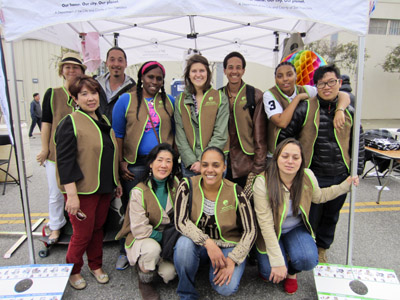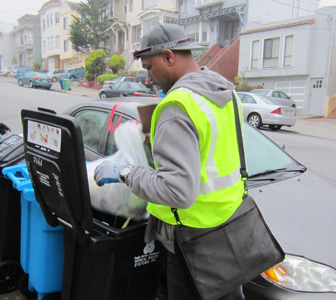Though it began nearly four years ago, many San Franciscans had never even heard of the City’s Environment Now green jobs training program until last month.

Most Environment Now trainees are graduates of other green-jobs workforce training programs offered by the City and have been referred on to Environment Now because they showed a keen interest in sustainability. Going door-to-door, they educate owners and tenants about proper sorting and answer questions. SF Department of the Environment
By Bill Picture
Published: May, 2013
Though it began nearly four years ago, many San Franciscans had never even heard of the City’s Environment Now green jobs training program until last month. That’s when Mark Boyer, a reporter from The Atlantic Cities, shadowed Environment Now trainees dispatched into neighborhoods before sunrise to sift through waste bins. The trainees collect data on how San Francisco households and businesses separate their recycling, compost and landfill-bound waste.
Environment Now outreach crews later use this data to go door-to-door, making a special effort to hit those addresses whose sorting could use some work. There, they educate the owners and tenants about proper sorting, answering questions and reinforcing the important role that each household and business plays in helping the City to meet its goal of being a zero-waste city by 2020.
"Nowadays we look at going door-to-door as being an aggressive tactic, but back in the day it was the preferred means to engage the public," said Environment Now Coordinator Cara Gurney. "Vacuum salesmen and encyclopedia salesmen went door-to-door because it allowed them to put a human face on their product."
The truth is, figuring out whether to deposit that scrap-of-whatever in your hand into the blue bin, the black bin or the green bin can sometimes be tricky business. And while every effort has been made to help the public with the process, most people still at some point find themselves standing in front of the three bins scratching their heads, then tossing the item into a bin and hoping for the best. "That’s why going door-to-door is so effective," Gurney said. "We can answer questions and have a conversation. It’s more human, and more effective than any brochure."
A landing spot for many types of people
Most Environment Now trainees are graduates of other green-jobs workforce training programs offered by the City and have been referred on to Environment Now because they showed a keen interest in sustainability.
But that’s pretty much the only thing that the trainees have in common. The team, which typically ranges from 15 to 20 paid participants—the program is funded through the City’s Public Trainee Service program, and trainees are paid a living wage for a 40-hour week—spans just about every age, race and socio-economic demographic.
"And given the fact that we’re knocking on people’s doors, it’s important that our team reflect the diversity of the community," Gurney said. "If someone knocks on your door, you’re more likely to listen to what they have to say if you share some common ground, for instance, they’re from the same neighborhood as you or speak the same language. Oh, we also speak multiple languages."
While trainees tend to skew younger, Gurney said Environment Now frequently has participants over age 55. "The younger people are coming from other job training programs," she said. "The green workforce is still a relatively new thing, and they want to be a part of it. For the older folks, it’s a transition—an opportunity to find a new career or a different career that mirrors their interest in sustainability and the environment."
Gurney says she’s also noticed a lot more women coming into the program lately.
"Environment Now is a landing spot for all types of people," she said. "Either way, they’re interested in what we’re doing, and we want to carry that interest forward."
Responses to Environment Now’s door-to-door canvasing vary, according to Gurney. Overall, however, she says team members tend to be well received. "We definitely have more conversations with people than we have doors shut in our face," she said. Gurney described a Russian family whose door she once knocked on:
"They didn’t speak any English at all but they invite me in and tried to feed me dinner. I couldn’t stay, but we did talk for quite a while about recycling and composting through charades."
Getting the Environment Now message across in the face of unusual circumstances like this is something that trainees are well equipped to do, Gurney said, thanks to a training program that includes plenty of role-playing, to help trainees negotiate a myriad of questions, and stay on-message.
"And once the discussion is rolling, we’ll go wherever we can go," she said. "We’ll include reduction, energy saving. Wherever we can go, we’ll go there."
More difficult to overcome than any language barrier or crotchety neighbor’s bad attitude, Gurney said, has been the relative inability to measure the program’s impact on the City’s waste diversion rates. "It’s easier with businesses because we give them a green bin; and the numbers change pretty drastically. With residential, the change is usually more subtle."
Still, there’s good evidence that Environment Now works. Two years ago, a campaign focusing on the Bayview neighborhood resulted in a 30 percent increase in diversion rates.
Bigger bang behind locked gates
Next on Environment Now’s to-do list is multi-family buildings, which means working with property managers to gain access beyond building security doors. "We have to connect with the managers and get them to allow our team to come in and chat with the tenants. It takes a little bit longer, but it’s worth the investment. Because of the amount of waste generated at one building, you’re talking about more bang for the buck," Gurney said. "We also want to increase our community presence and start engaging more community groups in our messaging."
That said, the core strategy will remain much the same. "Once we get into those buildings, it’s all about the face-to-face," Gurney said. "It’s the best tactic. They’re genuine interactions, and they help get people invested in the notion of recycling and composting. That investment, conveying the understanding of why this is important—that’s the first step in any behavioral change."
For more information on Environment Now, visit

Environment Now trainees move through San Francisco neighborhoods before sunrise, sifting through waste bins collecting data on how households and businesses separate their recycling, compost and landfill-bound waste. SF Department of the Environment

